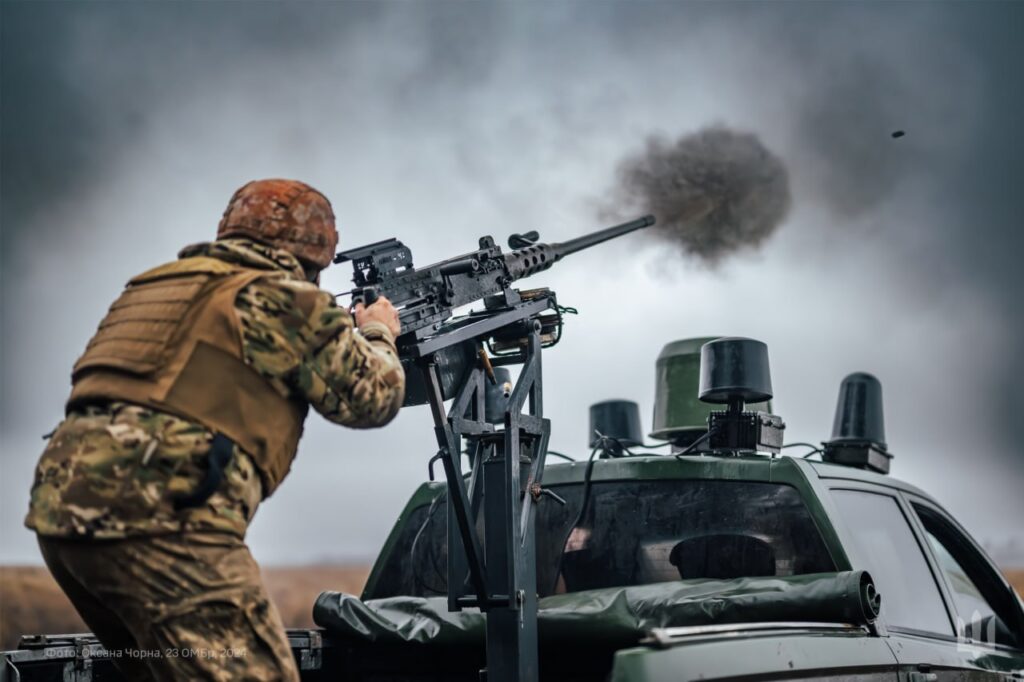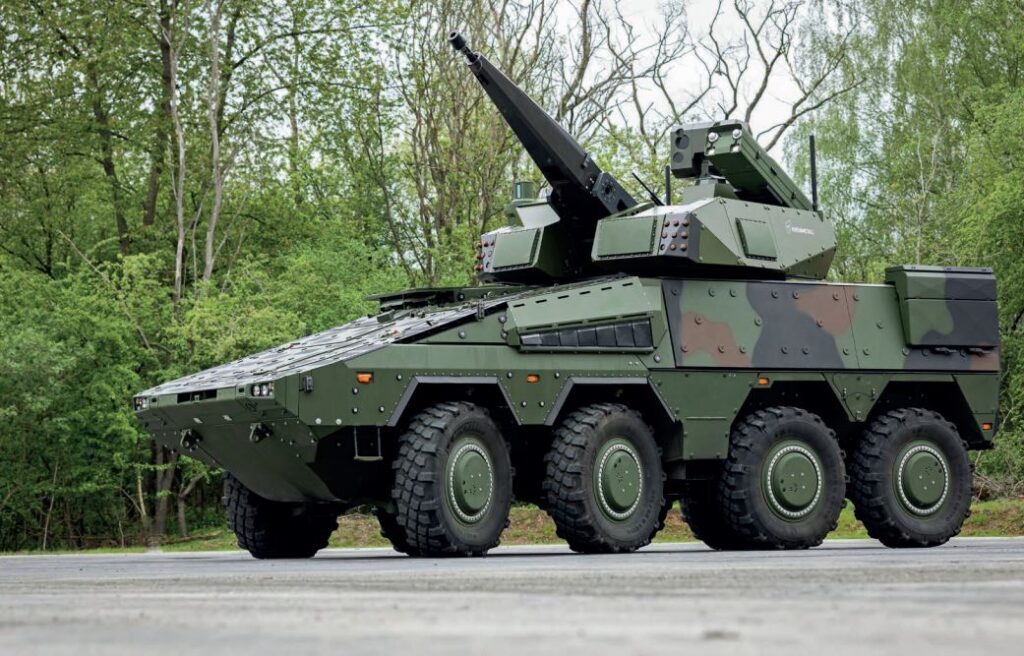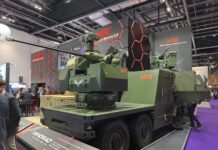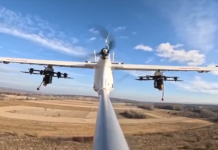Increasingly, militaries are pursuing short-range air defence (SHORAD) solutions to prepare for an era of near-ubiquitous unmanned aerial vehicles (UAVs) and loitering munitions, as well as dealing with the continued proliferation of cruise missiles, and rapidly evolving battlefield dynamics.
With concerns over the development of hypersonic weaponry and the introduction of more types of stealth aircraft from new players, it is easier to overlook short-range air defence (SHORAD). As the war in Ukraine illustrates, the ability to counter low-altitude threats – unmanned aerial vehicles (UAVs), loitering munitions, low-flying aircraft and rotorcraft, and cruise missiles – has arguably become more critical than ever before. SHORAD fills in the gap between longer-range and more costly surface-to-air missile (SAM) systems, dealing primarily with the immediate threats that can slip through their defensive coverage. This article explores why SHORAD matters, its evolving role on the battlefield, and the solutions reshaping its future – from truck-mounted cannons to experimental lasers and UAV solutions.

Understanding SHORAD
While some states may not face threats necessitating long- or medium-range air defence systems, they must still be prepared to counter low-altitude threats such as UAVs, loitering munitions, low-flying aircraft, attack helicopters, and cruise missiles, making short-range defences a fundamental necessity. Although threats are numerous at this layer of the air defence umbrella, they do not require the same complex solutions wielded by long- or medium-range systems. As such, SHORAD systems can encompass various types, including man-portable air defence systems (MANPADS), radar- and/or optoelectronically-guided medium-calibre cannons, short-range SAMs, directed-energy weapons, or a combination of one or more of these. It should be noted that traditionally, MANPADS and cannons have been grouped into the very short-range air defence (VSHORAD) category, but are also covered here as their target set overlaps heavily with that of SHORAD.
When employed effectively against certain targets, SHORAD can reduce the consumption of more expensive medium- and long-range SAMs. Short-range air defence weaponry can prove effective against threats including loitering munitions and cruise missiles. The use of MANPADS by Ukrainians has been observed in social media footage in areas surrounding Kyiv, against cruise missiles and one-way attack (OWA) drones such as the Shahed family.
The Ukrainians emphasised the high value they place on having a large quantity of MANPADS distributed to mobile air defence squads. Their use against cruise missiles, OWA drones, and other threats helps preserve Ukraine’s smaller stockpiles of high-end, costly munitions for systems such as PATRIOT or IRIS-T SLM. Local modifications to Stinger launchers have also enhanced operators’ ability to target aerial threats at night, further bolstering their effectiveness. Ukrainian representatives have often highlighted the struggle to procure or secure donations of MANPADS, despite Ukraine’s willingness to accept virtually any type of these systems including systems originating from either European or NATO states.
Additionally, an appeal has been made by Ukrainian representatives to increase MANPADS production. Despite such calls, the US Army only anticipates Stinger production to rise to 60 missiles per month by this year. Restarting production for a legacy system presents challenges, as many subcomponents are no longer manufactured, necessitating a partial redesign to integrate newer, available components. However, 60 Stingers per month falls short of expectations, especially when considering that these units are also divided between exports to allied countries and domestic consumption in the US.

The freedom to manoeuvre largely depends on safeguarding mobile units from aerial attacks, both from conventional and evolving threats. This is where the roles of counter-unmanned aerial vehicle (C-UAV) systems and SHORAD converge. Given that ‘C-UAV’ is still a relatively new term in the defence nomenclature, one potential distinction is that while SHORAD encompasses defence against a wide variety of threats, including UAVs, C-UAV focuses exclusively on UAV defence. However, some C-UAV solutions could double as VSHORAD/SHORAD systems, and vice versa.
For SHORAD, the need to provide coverage for mechanised units is not a new concept. However, defence budgets and manpower are both challenging constraints to navigate. While self-propelled anti-aircraft guns (SPAAGs) have traditionally been a vehicle subclass tasked with accompanying and protecting mechanised units, they have historically relied on tracked platforms – often the only type capable of accommodating heavy twin-gun anti-aircraft turrets. In many cases, these platforms were either unique or adapted from designs distinct from the vehicles they were intended to protect. Even the well-known Gepard, while sharing nearly all of its automotive components with the Leopard 1, is technically not the same hull, being approximately 8 cm longer due to a gap between the third and fourth roadwheels.
For modern armoured fighting vehicles (AFVs), there are already standalone products designed for integration onto various tracked and wheeled platforms, offering organic SHORAD solutions. Modern anti-air turrets are often significantly lighter than the turrets of the 1990s and earlier, typically featuring a single cannon with additional missiles as secondary armament, along with an unmanned turret. Furthermore, some are exploring the use of standard AFV armaments for SHORAD purposes. With the proliferation of programmable air-burst rounds for medium-calibre weapons, there is theoretical potential for armaments originally designed for ground targets to also employ suitable ammunition and competent fire control systems (FCSs) to track and engage aerial targets. As SHORAD and C-UAV roles increasingly overlap in addressing UAV threats – and as such threats proliferate across the battlefield – organic solutions may be trialled and refined, with an emphasis on leveraging readily-available resources rather than relying on bespoke designs.
Mobility and Flexibility
While Ukraine inherited a significant quantity of Soviet-era air defence equipment, being the second-largest country in Europe (after Russia) presented many challenges. Securing the airspace for its many population centres, military installations, and pieces of critical infrastructure requires many assets.

As is often inherent in defence, the attacker typically holds the advantage of choosing the time and place for an action, leaving the defender to anticipate a range of possibilities and distribute their systems accordingly. However, defenders can gain an edge by detecting the aggressor’s actions early, analysing what is likely to occur and what is required to counter it, and, in the case of air defence, deploying mobile systems that can be swiftly repositioned to meet evolving threats. This hinges on establishing a rigorous command-and-control (C2) network that integrates various sensor inputs, automatically classifies threat information, and rapidly relays targeting data to mobile air defence assets on the ground. To be effective against multidirectional and numerous threats along a wide front, SHORAD air defence systems must be mobile.
From SPAAGs to turrets
It is increasingly rare to encounter SPAAG platforms being marketed as standalone platforms. In truth, such a distinct class of vehicle is no longer purpose-designed as it once was. Largely due to advances in designing lighter weapons and sensors, standalone air defence turrets have become a common SHORAD solution, offering versatility by enabling integration onto user-defined wheeled and tracked vehicles without extensive redesign work.

The cannon also supports the proprietary Advanced Hit Efficiency And Destruction (AHEAD) ammunition, marketed for its C-UAV capability. This munition is time-fuzed, and the way it works is that the round’s muzzle velocity is first measured as it has nearly left the barrel, by a sensor close to the muzzle. When the projectile velocity data is combined with data on the target’s range, heading, and speed being continuously collected by the turret’s optoelectronic or radar sensors, the FCS is able to calculate the time at which the round should initiate for optimal effect at the predicted impact point. This timing data is then programmed into the projectile using an electromagnetic induction programmer located at the end of the muzzle brake; during this process, the round also harvests a small amount of energy from the electromagnetic induction programmer to run the round’s on-board electronic timer. The round then leaves the barrel and continues toward its point of aim. Once the electronic timer reaches zero, a small pyrotechnic charge initiates, which pushes the ballistic cap off the round. With the remainder of the round exposed, its payload of numerous tungsten sub-projectiles are dispersed in a spiral pattern toward the target. Dispersal occurs through the centrifugal force of the round spinning (since it is fired from a rifled barrel), rather than explosive force. Numbers of sub-projectiles vary depending on the precise variant of AHEAD used.
Aside from AHEAD, the Skyranger 30 can house a missile pod accommodating up to two MANPADS-class missiles, such as Stinger or Mistral. Following a July 2025 agreement between Rheinmetall Electronics and MBDA Deutschland, an option for pods containing up to nine Small Anti-Drone Missiles (SADMs) is also available.

The reemergence of truck-based SPAAGs
Mounting air defence cannons on trucks is hardly a new concept, but it is a vehicle type experiencing a resurgence of interest, with several manufacturers offering designs based on truck platforms. A likely motivation is cost reduction, achieved by using militarised commercial trucks as base platforms for air defence turrets derived from static or naval systems.
BAE Systems Bofors launched the Tridon Mk2 air defence system at Eurosatory 2024. This system combines the 40 mm Bofors 40 Mk 4 naval turret with a 6×6 Scania G 460 truck chassis. The ‘Mk2’ designation harks back to a 1990s project that explored a similar concept, featuring variants such as a basic, unprotected Bofors 40 mm L/70 cannon mounted on a Volvo 6×6 all-terrain wheeled vehicle comparable to the Volvo A30D used with the Archer self-propelled howitzer (SPH). Unlike the Mk1’s more bespoke chassis, the Tridon Mk2 employs what is essentially a commercial truck for military use. It is equipped with a Chess Dynamics Hawkeye Air Defence optoelectronic sight but lacks an onboard radar detection or tracking system, relying instead on networked data from external assets. A BAE Systems Bofors spokesperson noted that while the turret closely resembles its naval counterpart, the land version includes increased roof armour, despite being unmanned. Its lethality, particularly for the C-UAV role it is marketed for by BAE Systems Bofors, stems from the option of using the 40 × 365R mm (rimmed) 3P programmable ammunition. This round, programmed by induction, offers six modes that are selected based on the target, and include impact, timed, and proximity modes.

As a candidate for the UK’s land ground-based air defence programme, Moog Inc. has offered Reconfigurable Integrated-weapons Platform (RIwP) with the Supacat High Mobility Transporter 6×6, alongside another RIwP application onto KNDS Deutschland’s Dingo 3. The RIwP is a modular frame that supports various weapon systems, including machine guns, medium-calibre cannons, automatic grenade launchers, and missiles. Displayed at the IAV 2025 conference in January, the turret featured a single 30 × 113 mm M230LF cannon alongside eight Starstreak High-Velocity Missiles. An open day in late February 2025 highlighted the option to integrate two Brimstone missiles, reducing the Starstreak count to four – a tease on a potential British take on the US Maneuver-Short-Range Air Defense (M-SHORAD).

Through broader observation, many forces are increasingly favouring wheeled vehicles, with smaller and medium-sized forces in Europe increasingly seeing a higher proportion of their new armoured platforms being wheeled rather than tracked. Consequently, the adoption of truck platforms in SHORAD may reflect a wider trend as forces retire legacy tracked platforms and invest in new wheeled systems. These platforms, while optimised for road networks and requiring less maintenance than tracked vehicles, do not necessarily need to possess the same offroad characteristics as tracked vehicles if the mobile assets they may accompany are also wheeled.
Experimental and alternative solutions
High-energy laser (HEL)-based air defence systems have been in development for decades, yet progress towards a mobile solution remains incomplete in most projects. The closest to entering service for ground applications is Rafael’s Iron Beam-M (with ‘M’ denoting Mobile), with Rafael Advanced Defense Systems as the prime contractor. This laser boasts an output power of 50 kW and is primarily marketed for the C-UAV role. Compared to the static 100 kW Iron Beam, the mobile variant is believed to be a large system requiring multiple vehicles, including the laser weapon vehicles themselves, a command-and-control (C2) post, and possibly also a dedicated surveillance radar, and potentially one or more mobile generators.
While the range of Iron Beam-M is not publicly disclosed, the lighter 10 kW Lite Beam also from Rafael, and designed for integration with vehicles as small as 4×4s, has a stated maximum range of 3 km. Given that the 50 kW class Iron Beam-M would be expected to possess roughly double this range, this would theoretically provide a feasible VSHORAD solution, but with unknown purchase and maintenance costs, and considering the system’s reliance on multiple vehicles and a crew of at least a dozen personnel, its practicality remains questionable. Lite Beam offers a more attractive solution, being a standalone vehicle, however with such ranges, it can only be envisaged as potentially being suited against Class I or Class II UAVs, while Iron Beam could offer defence against larger Class III UAVs as well as OWA UAVs and cruise missiles. As prevailing opinion holds, Naval vessels may be the most likely first adopters of laser-based air defence systems, given they are capable of supplying substantial electrical power and already equipped with integrated sensors such as radars.

Deliberate or spontaneous attempts to use first-person view (FPV) UAVs to down helicopters have also been documented. At least one instance, shared in August 2024, allegedly showed a UAV striking the tail rotor of an Mi-28 helicopter. The outcome remains unclear to the public, as does whether the UAV was equipped with a specific defeat mechanism (such as an explosive warhead) or simply aimed to damage the tail rotor through collision. Such efforts suggest a potential avenue for developing dual-use or purpose-designed UAVs with sufficient speed to intercept slower conventional targets like helicopters, using manual or automatic targeting. This could provide an alternative countermeasure if MANPADS or anti-air cannons are unavailable.
Parting thoughts
SHORAD will always be an indispensable layer in air defence, underscored by its critical role in countering diverse and evolving low-altitude threats, from UAVs and cruise missiles to helicopters and ground-attack aircraft. The war in Ukraine has demonstrated SHORAD’s necessity, not only in preserving higher-end munitions but also in providing flexible, mobile protection for various assets and centres of significance. As threats proliferate across the battlefield, the demand for adaptable solutions has driven a shift from traditional SPAAGs to lighter, standalone turrets and truck-based platforms, such as the Skyranger series and Tridon Mk2, which leverage existing chassis to reduce costs and enhance on road mobility.
This potential evolution reflects a broader trend towards practicality and versatility. Mobility, enabled by lightweight systems and road-exploiting truck designs allows the defender to respond more rapidly to multidirectional and simultaneous attacks, a necessity highlighted by Ukraine’s need to balance coverage across vast territories. Meanwhile, programmable air-burst munitions, laser-based systems such as Iron Beam-M, and unconventional adaptations such as the R-73-armed Magura drones and FPV UAV usages signal a future where VSHORAD/SHORAD integrates a greater range of platforms while expanding its range of effectors. While challenges remain, including production limitations and the high costs of advanced systems, the convergence of organic, cost-effective designs with experimental alternatives can ensure a plethora of solutions to forces looking to cover gaps in their air defence networks or expand their SHORAD assets considerably.
Chris Mulvihill






![Challenger 3: Rising to the Challenge Only 148 of the British Army’s Challenger 2 MBTs will be upgraded to the Challenger 3 standard. [Crown Copyright 2025]](https://euro-sd.com/wp-content/uploads/2025/09/01_Challenger-3-RBSL_UK-MoD-Kopie-218x150.jpg)
![Developments in strike UAVs The Flyby Jackal launches an LMM during testing. [Crown Copyright 2023]](https://euro-sd.com/wp-content/uploads/2025/07/Jackal_Crown-Copyright-Kopie-218x150.jpg)


![Countering the aerial threat Based at NAS Key West in Florida, US Naval reserve squadron VFC-111 operates the F-5N Tiger II in the aggressor role. [USMC/SSgt Dengrier Baez]](https://euro-sd.com/wp-content/uploads/2025/06/A1-Kopie-218x150.jpg)
![Beyond the drone line: Lessons from the drone war in Ukraine A typical RF controlled FPV drone, shown during take-off. These little platforms have already reshaped the battlefield significantly, but in many ways have not yet reached their full potential. [Armyinform]](https://euro-sd.com/wp-content/uploads/2025/06/RF-FPV-Drone-Takeoff_Armyinform-Kopie2-218x150.jpg)

